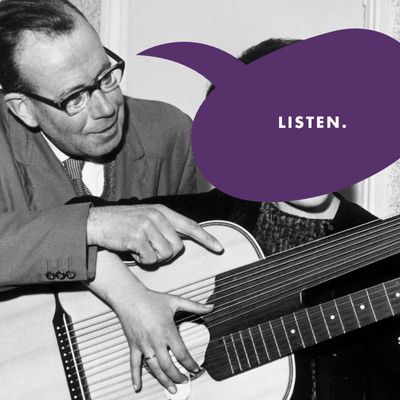
Here are two things society has taught me, as a man, to value: physical fluency, extreme technical proficiency. (Steph Curry’s three-pointers, splitting wood, stereo systems.) Here is what society has taught me, as a man, to regard with suspicion: the open expression of actual human emotions. And so: I love a guitar solo.
Let me clarify — not all guitar solos. I have no interest in the pyrotechnical finger wizardry of metal. I don’t love technique that much. The best guitar solos are produced by someone who understands the machine (indeed, a whole suite of machines: guitar, pedals, amp) and has mastered it with the extreme technical skill it takes to make things look easy, and yet nevertheless has figured out how to do what we musically ungifted and emotionally inarticulate men most wish for: the ability to communicate deep and profound feeling without having to speak at all. All we can do is listen, and be thankful.
Anyway, one particular guitar solo I love — or, more accurately, a pair of guitar solos that I love — perhaps encapsulates all that might be there to love about guitar solos. Guess what. The band is the Grateful Dead, and the solos I love are the two in the version of “Sugaree” from Dick’s Picks Volume 3, which is a live recording from 1977. Which, I know, I know. Here’s the thing about the Dead — and I am not a wacky Dead obsessive, but I do, unfortunately, like the Dead — is that there is so much of it. And, to my ear, so much of it mostly … sounds the same. Still, as a sorta interested Dead fan, you listen to a lot of the merely so-so — the muddy recordings, the lackluster performances — in hopes of finding the great.
This “Sugaree,” all “Sugaree“‘s, is gently paced. Like any normal song, it has verses and a chorus and all that (the chorus goes “Shake it, shake it, Sugaree,” which is a horrifying thing to have to type), and built into this song are two guitar solos. The thing about Dead solos — “jams,” if you will, and I wish I didn’t have to — is that they expand or contract based on … I don’t know, whatever it takes to get six people to do the same thing at the same time, how high everyone is or isn’t, the vibe, you know, just feel it. Still, the song has a set structure, an underlying grammar — they are all speaking the same language, as they enter into a “Sugaree” jam (ha-ha-ha-ha), but they don’t always know exactly what’s going to be said.
Extending that metaphor: bad guitar solos, probably the ones you are imagining when you think “Grateful Dead jam,” are just aimless babbling. They begin nowhere; they go nowhere; they end unsatisfyingly. (I told a friend that I’d been charged with mansplaining guitar solos, and she called them “the pumping-away-without-noticing-your-partner of music.”) The best are narrative: intro, establishing the scene, rising tension, rising tension, climax, denouement, stick the dismount, and back into the song proper. The thing you have to remember is that your guitarist, if he is good enough, can do whatever he wants, whenever he wants — it’s about patience. (This is why, like, Van Halen solos are so boring: too much pyrotechnics, not enough patience.)
At this point, it should be said that I couldn’t have thought almost all of this without my older brother, who has taught me almost everything I know about the Dead, the guitar solo. In fact, as men, this is one of our primary means of bonding. As I began to think about guitar solos, I sent him a text on a Saturday afternoon: “Tell me your five favorite guitar solos.” His reply: “Can it be top 20?” And I thought: my dude. He’s the guitarist, the one who taught me to love tone, to appreciate patience, to hear narrative. On his list of 20 solos, he included “any ‘Sugaree’ from 1977, preferably over 15 minutes long,” which is exactly what the “Sugaree” at hand is.
The first solo in this “Sugaree” is a joy. The guitar tone is sunny, with a citric bite of distortion. The band moves together, and Jerry’s fluttery arpeggios gather momentum, turn harder, more jagged, and finally crest into a wave that breaks all at once.
But there’s one moment in particular that makes me love this “Sugaree” more than any other. It’s in the second solo. Having started gently, things are getting hectic; tension’s building up to the crashy-bangy crescendo. After some fast-moving doodly finger-pickery, Jerry moves up the neck — and then — and this begins at 9:03, for those following along at home — things shift a little, the band clears some air, and he plays these beautiful, shimmery whispers. I am talking about two seconds here. It gets too fast after that, never quite resolves the way the first solo does.
But those two seconds! There’s something so searching, so plaintive — blissfully sad — and in it, the promise that even if you feel like you’re mostly making it up as you go along, if you prepare yourself, and keep trying to say something right, even though most of it is mostly garbage, someday you might be able to produce this one moment of just-right, transcendent beauty.
You probably won’t love it as I do. That’s fine. I only ask that you hear out the benign mansplainers of the world. Not the self-important blowhards, not the condescenders, not the dumb jerks pretending to know the things you actually do, but the ones who want to say: Listen to this song, watch this video of grown men on skateboards, look at this boat. He is just bungling his way toward feeling, toward connection, toward, oh god, what am I about to say, oh no — love.


